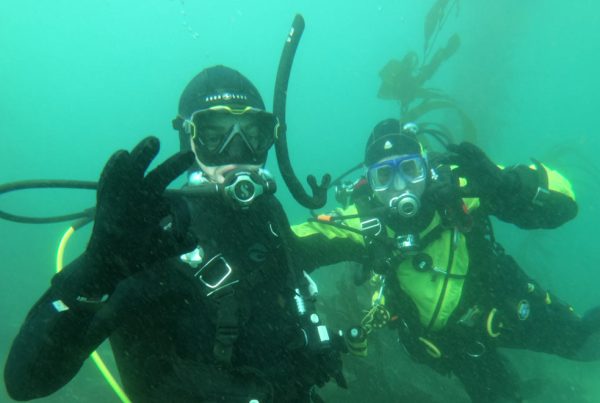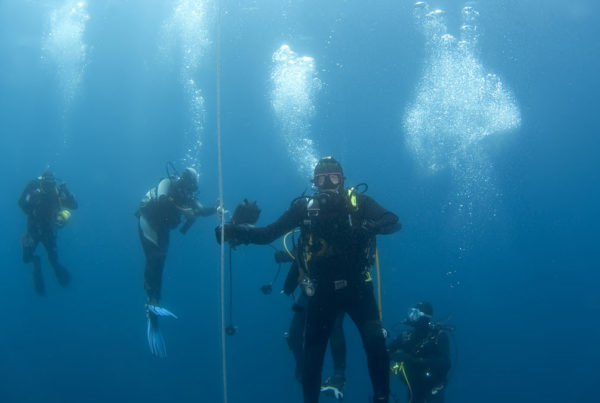Wetsuits represent a substantial investment in your cache of diving equipment. Lower end models run at least a couple hundred dollars where as high end, custom suits can represent investments of up to $500 or more, often more than what is spent on a regulator or buoyancy compensator. Why is it then, do we so badly abuse our wetsuits? Probably because we think we can get away with it. But abuse leads to colder diving, faster deterioration of the suit, and eventual failure—and we blame the suit.
Wetsuits are more durable today then they have ever been. Even so, some simple steps will get you more dives from your suit and, more importantly, more comfort from each one of those dives.
ANTI-ROT
“What is that SMELL!?”
Always rinse a wetsuit thoroughly in freshwater after use. Because a wetsuit is against your skin, organic compounds are transferred. Also, 79 percent of all divers say they urinate in their wetsuit (the other 21 percent lie). Then there is the ocean stuff that you pick up from the bottom on the outside of your suit. These compounds create a haven for bacterial growth and bacteria STINK!
Should you put your wetsuit in a washing machine? I would not recommend it, although I know some people that do it in the gentle cycle. What would you do with a $500 tuxedo or dress gown? You can’t take a wetsuit to the cleaners. They wouldn’t know what to do with a wetsuit. You have to hand wash it. About every two dozen dives or so, or whenever your nose tells you it’s needed, hand wash your wetsuit in warm (not hot!) water with a very mild detergent, preferably something specifically made for wetsuits available at most dive stores. And finally, allow the suit to dry completely out of the sun before storage.
A rotting wetsuit is not just an offense to the nose, it’s hard on the suit. It can breakdown the bond between the nylon lining and the foam neoprene rubber, causing separation. In more severe cases, seam stitching and edge tape is rotted away. Chlorinated pool water is also hard on wetsuits, so a good rinse after a pool session is a must.
ANTI-CREASING
Always store wetsuits hanging over a rounded plastic hanger. The more closely the hanger approximates your shoulder, the better. Wetsuits that are hung on thin hanger, or worse, stored folded, develop permanent creases at points on the knees, elbows and, in particular, the shoulders. Only a few dozen times of improper storage and the suit will be permanently thinned at these points so as to provide little or no thermal protection whatsoever.
STORAGE
In addition to storing a wetsuit on a proper hanger, you’ll want to store it in the right place. Keep it out of the sun. While it’s drying, keep it in the shade. Ultra-violet radiation from sunlight can do considerable damage to wetsuit over time. After it’s dry, store it in a cool, dry area with some air circulation and free of vermin.
ZIPPERS, CLASPS, AND VELCRO
Keep them clean! At the risk of giving away my age, I remember metal zippers that you HAD to lubricate or they did not work on the next dive. Nylon plastic zippers are much more forgiving. Even so, a little bit of lube goes a long way for a quick zip. Don’t use too much as this will just make the sand and dirt stick to the zipper easier. Use a light coating of silicone grease or specialty zipper lube available at most dive stores.
Metal clasps on beaver tails are still available on some model suits. These can corrode if not properly cared for. A regular squirt of silicone spray is all that is needed to keep them in proper working order.
Velcro is more commonly used now for beavertails and other wetsuit closures. While it’s a great material, it can get clogged with sand and other debris. Clean it regularly but gently with a stiff brush to keep it working at its best.
SEAMS AND DAMAGE CONTROL
When a wetsuit gets bad is usually because a small problem is ignored. A loose thread on a seam is a prime example. Trim the thread back (never pull on it!) and secure the loose end with a dab of Aquaseal, wetsuit cement or similar glue. Deal with external material tears promptly with iron on nylon material (available at most dive stores). Seam separations need to be repaired immediately, preferably by a professional.
RETIRING A WETSUIT
Wetsuits have a lifespan. Every time they are stretched and contracted to put on and take off; every time they are compressed and decompressed in diving, they never quite bounce back all the way. It used to be said that you could expect about 200 dives out of a good quality wetsuit. Now it is probably more, say 300 dives, depending on the material. The point here is if your wetsuit is no longer fitting you properly (other than for obvious reasons), or keeping you warm, and you’ve had and dived the suit for some time, it’s time to start thinking about a new suit.
Other signs that tell you it’s time for a new suit include seams that have been repaired so many times that the suit is getting stiff, nylon that is separating from the neoprene rubber, and color that is fading.
Wetsuits represent an important piece of your dive gear entourage, essential for your underwater comfort, and a substantial investment. Take just a little time and effort in caring for your suit and it will serve you well for years.










